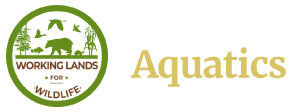About
About WLFW
A large and diverse group of partners and partnerships collaborate to effect conservation across large working landscapes — balancing economic goals and ecological needs in rural communities. This web portal will support the preservation of working landscapes, focusing mainly on Farm Bill conservation programs managed by the Natural Resources Conservation Service (NRCS) and its Working Lands for Wildlife partners.
Our WLFW site provides:
- Technology transfer between NRCS and its large spectrum of Working Lands for Wildlife partners and initiatives
- Back-and-forth sharing of learning materials, applied science, and field insights among professional biologists, foresters, and other experts and between NRCS and other professionals
The strength of this site is that it allows for better collaboration and information sharing across initiatives. In addition, we also support private workspaces for each initiative to share and edit draft documents, preliminary data, sensitive materials, and other information not intended for broader distribution.
The Working Lands for Wildlife (WLFW) program develops win-win approaches with producers and private landowners. WLFW partners understand collaboration is critical to enhance wildlife habitat and improve agriculture and forest productivity. We can continue strengthening collaboration- especially between technical experts from federal and state agencies and non-government partner staff- through the WLFW web portal and workspaces. The WLFW web portal and workspaces provide online infrastructure and space for partners to share their expertise, exchange resources and ideas, and plan work together on a certain species, a given habitat or land use, or a specific project. A subset of the resources here are available to producers, landowners, and communities who are interested in, or involved with, the WLFW program.
Aquatics Connectivity Framework
The Aquatics Connectivity Framework will lay out a 5-year plan with priority areas and conservation practice goals developed by NRCS with local partners across the country in states harboring high aquatic biodiversity from Texas to Florida and north through Appalachia and the Mid-Atlantic; we are tentatively expecting at least 16 NRCS state offices to participate in development and delivery of the Aquatics Connectivity framework and the document will be released in FY 2024.
The participating NRCS state offices have identified priority areas for aquatic conservation based on NRCS and partner priority species, habitats, and threats to aquatic resources. They then selected the appropriate EQIP conservation practices to address these threats. Each state sets specific goals for the number of acres, feet, miles, or other relevant units it aims to implement in these target areas over five years.
The priority conservation practices NRCS state offices have selected to address threats to aquatic resources fall into four main categories or “conservation solutions”: Riparian Forest Establishment, Crop and Grazing Water Quality Management, Wetlands Management, and Stream Habitat Management.
Practices include:
- Livestock exclusion fencing
- Prescribed grazing
- Cover crops
- Residue and tillage management
- Nutrient Management
- Riparian Forest Buffer
- Aquatic Organism Passage
- Wetland Wildlife Habitat Management
- Wetland Creation/Enhancement
- Streambank and Shoreline Protection
- Stream Habitat Improvement and Management
These practices will be implemented in target geographies across 16 states to achieve landscape-scale improvements in aquatic habitat conditions. Anticipated outcomes include increased biodiversity, improved water quality and availability, preserved or enhanced habitat connectivity in streams, wetlands, and riparian zones, and improved productivity and climate resilience on working lands.


























